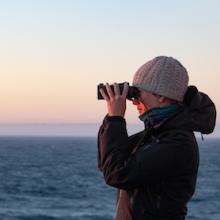
Kirsten Lindquist
Tell us about your work/research. What kinds of things do you do?
I am the Ecosystem Monitoring Manager for the Greater Farallones Association. Our mission is to protect the marine ecosystem in the greater San Francisco bay area through education, ecosystem monitoring, and ecosystem resilience planning. As the science program lead, I manage a variety of research projects in partnership with the Greater Farallones National Marine Sanctuary with the goal of informing managers about how sanctuary resources are changing, and to inform management actions. My work spans a wide range of habitats and monitoring protocols. Along the coast we engage high school community-scientists in rocky intertidal and sandy beach monitoring, and adults in wildlife, human activities and oil pollution monitoring. At sea, we monitor pelagic wildlife, water column, and benthic ecosystems. From the sea’s surface I quantify seabird and whale abundance, and beneath the sea, I do the same for rockfish and coral. All that fun requires a lot of time in the office; training community-scientists, writing reports, data management and analyses, and maintaining emergency response preparedness in the case that an oil spill impacts our sanctuary resources. All of this to maintain a finger on the pulse of our ocean ecosystem, it’s inhabitants, and systems!
What sparked your initial interest in your career?
As a small child I was fortunate enough to spend summers sailing the nearshore waters of New England. I was fascinated with the vast ocean waters, the strange wonders that were pushed up onto the beaches and abundance of life in tidepools. I counted jellies, and gulls as they passed by our boat. I looked for whales and scouted tiny granite islands cataloging everything I saw. I also read books like Never Cry Wolf by Farley Mowat and wanted to live alone in a tent like the protagonist and study wild things, a boat or island would also do.
Who influenced you or encouraged you the most?
Two teachers had the biggest influence on me and my career path. My high school science teacher, Dan Norris, who built my observation skills and stoked my sense of wonder. And college professor, Lorayne Meltzer, who introduced me to Bahia Kino in Sonora Mexico and the Midriff Islands of the Gulf of California. She modeled applied marine conservation, working with communities and ecosystems. And my parents, my mother who gave me a keen eye, and my father physical confidence in nature.
What element of your work/study do you think is the most fascinating?
The diversity of marine life, from albatross soaring above the ocean to deep sea coral, and their unique and beautiful adaptations to life on earth. Whose elegant solutions to life did not include pressures like monofilament, marine sound pollution, and oil spills. And the diversity of monitoring methods we employ to gather information about all aspects of ecosystem status and health.
What other jobs led you to your current career?
Early on in my career, I worked on islands and ships throughout the Pacific Ocean. Ranging from the Bering Sea, the Northwest Hawaiian Islands, Juan Fernandez Islands, Antarctica, and the Farallon Islands. While working in extraordinarily remote locations I was given opportunities to engage in many aspects of marine ecosystem and island ecosystem monitoring. Conducting at-sea surveys for marine mammals and seabirds transiting to an island, then conducting nest monitoring, plant phenology, diet studies, sea lion breeding censuses, deploying satellite or dive loggers on wildlife, subtidal surveys, and in the deep sea.
What are your degrees and certifications?
I have Bachelors in Marine Conservation from Prescott College
I am SCUBA certified
I have HAZWOPER 24 for working in “hot” zones during an oil spill
What are your hobbies?
Adventuring: hiking with my dog. Backpacking, swimming, birding, and sea kayaking.
At home: gardening, cooking, reading, DIY home projects.
How did you get involved with the Ocean Exploration Trust?
Ocean Exploration Trust has partnered with the Office of National Marine Sanctuaries to focus exploration in sanctuaries on the US west coast. I work with NOAA sanctuaries and was invited to participate in the expedition to Cordell Bank National Marine Sanctuary and Greater Farallones National Marine Sanctuary.
What advice would you give someone who wants to have a career like yours?
Apply for internships and hands on experiences as early as possible. Work hard and build relationships. Earn strong references in the field before graduating from undergrad. Work in the field and get varied/complementary experience to ensure you are really passionate about the day to day realities of your subject and know what questions you want to ask before committing to graduate studies.
Expeditions
Kirsten participated in the following Ocean Exploration Trust expeditions:
